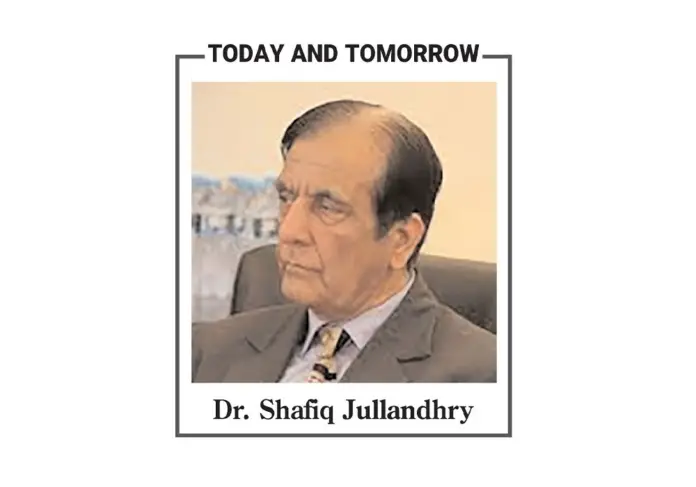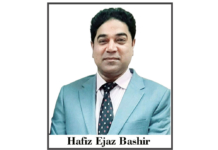From the 1960s to the 1990s, the New Campus of the Punjab University had an ideal environment. Located on the right bank of Lahore Canal and having lush green lawns and flower beds all around, every youth’s dream was to get admission to any department on the campus – renamed as the Quaid-e-Azam Campus. During those years, the New Campus was considered very far away from the main city and was linked with the rest of the city via a double-decker bus service. Buses of routes number 27 and 28 were plying between Rang Mahal and the New Campus. The Journalism Department, now the School of Communication Studies, was on the top (third) floor of the Institute of Education and Research (IER); this building was located in the extreme southwestern corner of the campus, close to the right bank of the Lahore Canal.
On the left side of this building, there is a beautiful Faisal Auditorium of the university. After a small parking place, there is a canteen of IER. Surrounded by green lawns, it is still a busy place on the campus. On the other side of the Faisal Auditorium, there is the Department of History, Department of Economics, Department of Sociology, and Department of Public Administration.
After some years, Institute of Chemical Technology, Centre for Solid State Physics, Centre of South Asian Studies, Centre of Pakistan Studies, and Centre of High Energy Physics appeared nearby. The present School of Communication Studies, MBA, MPA, English, MBIT, Psychology, and all other departments were shifted to their current locations after 1990. Nevertheless, the Department of Mass Communication, which converted into the Institute of Communication Studies in 2004 and then into the School of Communication Studies in 2022, was the first to come into this area.
I belong to Toba Tek Singh, and received my education up to matriculation in this small town. Until the 1960s, it was a small peaceful town. Along with town culture, we also experienced village culture in our school. Almost half of the students in our high school belonged to the surrounding villages. Many of them were coming from three to six miles away by riding their bicycles. They all used to bring a cotton bag containing books and clothes. At their entry in the morning and exit in the evening, we experienced an exciting view outside of the school’s boundary wall. All the village students wearing chadar/the band [un sewed piece of cloth] used to bring their pajamas (trousers) in their bags, the reason being that chadar was not proper dress and was not allowed to wear in the school.
We witnessed every morning and evening the village students changing pajamas with their chadar. When asked why they don’t come from their villages in pajama, what is the particular need to change it every time outside of the school? They said that pajama is not their village culture. When they are seen dressed in pajamas in village, people start ridiculing them in their own areas. Even the village dogs refused to recognize them in pajamas and started barking at them. After passing my matriculation, I came to Lyallpur (now Faisalabad), there were more students from different sub-cultures. But in Lahore, especially inside the Punjab University, students were joining from almost all other districts of the Punjab province; they used to enjoy the company of quite a lot of sub-cultures. The students loved to tell about so many unique traditions, places, and superstitions of their areas, which undoubtedly enhanced their vision whenever they could sit together.
Lahore being the most significant and historical city, the province’s cultural, economic, and political hub had great attraction for the youth of small places. Besides their educational institutions, there always has been so much to learn from the Wall City, centuries-old Lahore Fort, Badshahi Mosque, Minar-e-Pakistan, Lahore Museum, Lahore Zoo, Jinnah Garden, great public libraries, Shalimar Garden, Data Darbar, Anarkali Bazar and Urdu Bazar. There are wholesale markets and many modern malls like Hyper Star, five-star hotels, MM Alam Road’s excellent eateries, Metro Bus, Orange Line Metro Train, food streets, newspapers, television channels, Alhamra Arts Council, Gaddafi Stadium, and other sport grounds. Moreover, famous poets like Amjad Islam Amjad, Atta Ul Haq Qasmi, and Shoib Bin Aziz, journalists like Mujeebur Rehman Shami, Jameel Athar, Salman Ghani, Ayyaz Amir, Sohail Warraich, and Yunis Butt, and intellectuals like Khalid Mehmood, Qayyum Nizami, Sajjad Mir, Afzaal Rehan, Javed Nawaz, Dr Muhammad Afzal, and Khalifa Zia-ul-Din all reside in Lahore.
Undoubtedly, social media has fatal effects on social gatherings; even then, platforms like Maulana Zafar Ali Khan Trust, Nazriya Pakistan Trust etc were continuously arranging intellectual and cultural discussions. All six departments of the School of Communication Studies are actively organizing such programs to enhance their students’ ability to understand the world.
The school’s senior faculty, including Dr.Noshina Saleem, Dr.Shabbir Sarwar, Dr.Sawera Shami, Dr.Waqar Malik, Dr.Rashid Khan Barakzai, and Dr.Bushra Hameed, and Dr.Abida Ashraf, are actively patronizing such programs. Before coming to the present six departments of the School of Communication Studies, in my next column, I would like to discuss my teachers Waris Mir, and Dr.Mehdi Hasan of the then Journalism Department.







